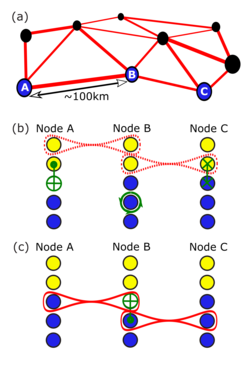The challenge: Realizing a large quantum network!

(a) A quantum network consists of stationary nodes that are connected by optical channels. Photon loss limits the distance of direct links to ~100 km. (b) This limit can be overcome in a "quantum repeater" networking architecture: Each node is equipped with several qubits. A subset (yellow) called ‘communication’ qubits couples to the optical channels for probabilistic entanglement (red dashed) between remote nodes. Additional ‘memory’ qubits (blue) are isolated from the optical channel. Each node allows for deterministic local qubit control (green). (c) If a ‘herald’ signal unambiguously tells whether a remote-entanglement attempt was successful, then memory qubits in neighboring nodes can be entangled deterministically (red) using a repeat-until-success strategy. Local operations then generate an entangled state of the outer nodes even if their separation is too large for a direct photonic connection.
The rapidly increasing level of control over individual quantum systems has led to the dream of a ‘second quantum revolution’, which means the development of novel technologies that employ quantum mechanics to achieve tasks unachievable by any classical device.
Three particularly promising applications have been explored during the past decade: First, a quantum computer that can fundamentally enhance computational power once it is scaled to a large number of connected quantum bits (qubits). Second, photon-based quantum communication, which can guarantee unbreakable encryption but still has to be scaled to global distances. Third, quantum sensing, which promises unprecedented sensitivity once scaled to a large number of entangled quantum sensors.
A quantum network, which is a hybrid system of stationary and flying qubits, could tackle the scalability problem of each of these fields: that of computation and sensing by use of an optical interconnect between small quantum processors or sensing units, and that of communication by use of intermediate network nodes in a quantum repeater. Yet, the scalability of quantum networks still has to be shown, which requires a protocol that does not lead to an exponential reduction of fidelity and efficiency when increasing the size of a quantum network.
Albeit such protocol, called a quantum repeater (see figure), has been proposed three decades ago, its experimental realization is still an open challenge. Achieving this goal using a novel experimental platform based on Erbium-doped crystals is the main research goal of the Quantum Networks Group at MPQ.
